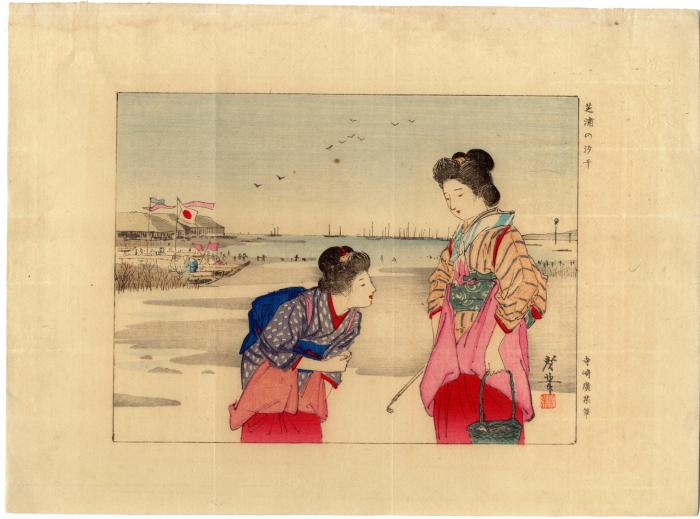Terazaki Kōgyō (寺崎広業) (artist 1866 – 1919)
The ebb tide at Shibaura (Shibaura no Shiohi - 芝浦の汐干): Two girls gathering clams
08/1895
12.125 in x 9 in (Overall dimensions) Japanese woodblock print
Signed: Terazaki Kōgyō hitsu
寺崎広業筆
Museum of Fine Arts, Boston - Eisen of ships returning to Shibaura
British Museum - modern print of what Shibaura looked like in 1989
Ritsumeikan University Shibaura is located along the coast southwest of the older parts of the city.
"Shibaura [芝浦] means "Shiba coast." Its main factories on land reclaimed by the shogunate, the company [Tokyo Shibaura] was an early manufacturer of telegraphic equipment. In spite of all these industrial endeavors, Shibaura remained the most popular of watering places. The young Tanizaki went there gathering clams.
Shibaura had clams in spring and cooling breezes in the summer, and a view up the Sumida to Ryōgoku Bridge for the "opening of the river." Meiji graphic art tends, except in certain erotica, to emphasize the clams. It was only at the end of the period that the youth of the land turned with enthusiasm to sea bathing. Advertisements from middle to late Meiji recommend it as something which, since foreigners find it pleasant and healthful, Japanese might try too. The places where pretty clam-diggers posed for photographers, skirts tucked up to reveal sturdy legs, now lie beneath a freeway, and already at the end of Meiji reclaimed lands were creeping eastwards."
Quoted from: Low City, High City by Edward Seidensticker, pp. 226-227.
****
Shibaura according to a September 25, 2011 article by Kit Nagamura in the Japan Times is in the Minato Ward. Today it is filled with high rise buildings and is close to the Tokyo Institute of Technology and not far from Keio University to its northwest.
It says: "Until late in the Meiji Era (1868-1912), the Shibaura area consisted of a grassy shoreline, home to fishermen and clam-diggers. A nearby promontory, Tsuki no Misaki (near present-day Kamezuka Park), was famous for its moon-viewing vista over the shore below and out to sea. The promontory still exists, but by the end of the Meiji Era it had lost its appellation because new buildings on the landfilled margins of Tokyo Bay had begun to obscure the view."
****
There is another copy of this print in the Museum of Fine Arts in Boston, but it is unillustrated. While they are aware that it was a frontispiece to a magazine or book they are unable to identify the original source.
****
One online site states that the publisher of this print was Hakubunkan (博文館).
Magazine or book frontispiece (kuchi-e - 口絵) (genre)
Meiji era (明治時代: 1868-1912) (genre)
